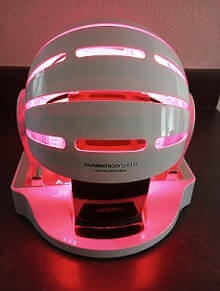
In my post on the best laser hair growth devices, one of the products I covered was the iRestore laser helmet from Freedom Laser Therapy. Until 2023, the company made two devices that they call laser hair growth systems. Sometimes they also use the terms “laser cap” and “laser helmet”.
- The iRestore Essential with 120 lasers and LEDs (light-emitting diodes). Current average rating of 3.9 out of 5 stars across 3,800 reviews on Amazon. On sale for $500 after $100 coupon.
- The iRestore Pro with 282 diodes (both laser and LED). Current average rating of 4.2 out of 5 stars across 940 reviews on Amazon. On sale for $800.
iRestore Elite Laser Helmet with 500 Diodes
In 2023, Freedom Laser released the newest iRestore Elite model with a huge 500 combined laser and LED diodes. The white color of prior models has been replaced by a sleep black appearance.
This device is FDA cleared for home use for hair regrowth purposes.
According to the company’s website, the iRestore Elite comes with the following features and advantages
- 500 diodes (Lasers & LEDs). The most in any home-use laser hair growth device on the market. I have not tried to verify this claim.
- 2500 mW total power output.
- Brief daily 12-minute treatment time.
- Unique triple wavelength red light technology (625/655/680 nm) for deeper scalp stimulation. Make sure to read my post on low-level laser therapy (LLLT) and wavelength.
- Proprietary Lumitech™ red light therapy.
- Advanced vertical-cavity surface-emitting lasers (VCSELs).
- A patented extended scalp coverage for maximum effectiveness. It stimulates hair follicles in the temples, crown and hairline regions of the scalp.
The lasers are medical-grade VCSEL with a wavelength of 680 nm. The LEDs are medical-grade with wavelengths fo 625 nm and 655 nm. Kevin Chen, the president of iRestore, says that the Elite is the most powerful hair growth device for home use. It is sometimes called the “Ferrari of Hair Growth Devices.”
The iRestore Elite device can be purchased for $1,900 after a $600 off discount offer with a promo code. You can also buy a rechargeable battery pack that is on sale at $89. A 3-year warranty is included, and it can be extended to 5 years for an additional fee.
What’s Included
The hands-free helmet (not cap) itself has a ventilated design with adjustable soft foam pads so as to fit every head size perfectly. IT weight only 1.2 lbs.
Included in the purchase price are:
- The iRestore Elite device.
- A universal power adaptor.
- A controller with timer display.
- User manual.
- Quick start guide.
- A protective carrying case.


